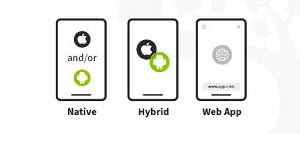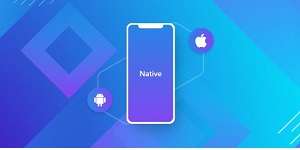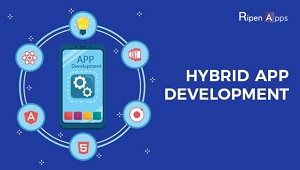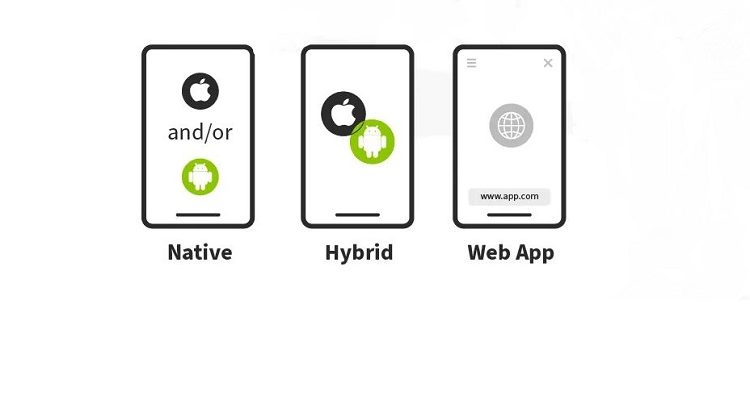Native App Vs Hybrid App Development
Pros and Cons of Hybrid Vs Native App Development
What is Native App Development?

Source: Interaction Design Foundation
Apps created only for one platform are referred to by the name. A native app is made using platform-specific tools and coding languages. It might be a native Android app created in Kotlin or an iOS app created in Swift and Objective-C.

Source: Mind Inventory
Although they require a lot of effort to develop, native applications are user-friendly and produce a high-performance user experience. The platform UX includes all of the graphics and essential features. Startups frequently opt for other choices since the high cost of native app development is the sole drawback.
Native applications interact with the operating system of the device in a way that makes them speedier and more adaptable than other application kinds. Developers provide a different version of the app for each device if users of different device kinds use the app.
For instance, the HTML5 code for the Facebook application was originally used for mobile web, iOS, and Android. Facebook’s app engineers produced distinct code for iOS since the app was slower for iOS users. Complex activities, including networking carried out in the background of the main thread or programme that controls the UI, can be rebalanced by developers.
WHAT IS HYBRID APP DEVELOPMENT?
The idea behind hybrid app development is to create a single code bar for several platforms. With the use of certain technologies, communication between the platform and the web view may be established, giving hybrid app development the appearance and feel of a native one.

source: RipenApps
Web technologies including JavaScript, CSS, and HTML are used in the app creation. After the code is created, a native app is created around it utilizing cross-platform frameworks like React Native. Hybrid apps offer the same user experience as native apps even if they are created using web technologies.
Native Apps vs Hybrid Apps Comparison
In the world of mobile applications, not all apps are created equal. Native apps, web apps and hybrid apps development are different in many ways.
Before comparing the differences, let’s first look at how each of these types of apps vary, followed by the advantages and disadvantages for each. The purpose of this article is to show a comparison of native apps vs hybrid apps development, but we will also cover web apps for the sake of completeness.
Applications that combine native and web apps are called hybrid apps. Although a hybrid app downloads as a native software, it functions inside like a web app. In order to leverage resources like the camera, storage, and GPS, hybrid apps must have access to internal device APIs. Examples of hybrid app development include Yelp and Instagram.
With HTML and CSS, developers create hybrid apps.
They generate a single codebase, then tweak it slightly to make the programme compatible with each platform. In comparison to completely native apps, hybrid apps require fewer developers that are committed to each platform. The development of hybrid apps often involves running a web application in a container or WebView, a browser that may be housed inside of a mobile app.
The performance of hybrid apps differs from native apps in a number of ways. Web apps serve as the foundation for hybrid apps, which share their navigational components. A hybrid app also requires an internet connection to function; there is no offline option. In contrast, native apps support offline use.
Defining Native vs. Web vs. Hybrid Apps
Let’s start by defining each of these types of apps:
Native apps
Native applications are mobile apps created particularly for an OS, such as iOS or Android. When we consider smartphone apps, this is often what comes to mind. They are installed on a smartphone after being downloaded from the Google Play or App Store.
The fact that native applications are created for certain devices sets them apart from mobile web and hybrid apps. For instance, iPhone applications are written in Objective-C or Swift, whereas Android apps are written in Java. A native app has the benefit of being the quickest and most dependable in terms of user experience. Native applications may communicate with all of the functionalities of a device, including the microphone, camera, GPS, device storage, etc., because they are created utilizing an operating system’s SDKs. The drawback, however, has to do with the expense of creating and maintaining apps. If you wish to develop your app for various platforms (such as iPhones and Android), you will need a larger budget, which also applies to any ongoing upgrades required to keep your native app current.
Web apps
Websites that have been optimized for mobile browsers are web-based apps. They were created specifically to be viewed using a web browser. They are created in JavaScript and HTML5 and are compatible with a variety of browsers, including Chrome and Safari.
These apps resemble mobile apps even though they are really just interactive webpages. The benefit is that these applications are frequently less expensive to produce, though.
Building a web app may be the least expensive choice if you’re on a tight budget and don’t need access to operating system capabilities or advanced functionality. The drawback of online applications is that they may be slower, less user-friendly, and not available through app stores.
Hybrid apps
In hybrid app development, native and web app functionality are combined. They may be downloaded from app stores and viewed through web browsers. Like web applications, they are created using HTML5 and JavaScript. They are primarily web pages that have been wrapped in a mobile app utilizing WebView. However, they also have access to a device’s in-built features. React, Ionic, Sencha, and Xamarin are a few examples of cross-platform frameworks used to create them.
Hybrid apps have the benefit of often being simpler and quicker to design than native apps. Additionally, they require less upkeep. However, the speed of the user’s browser will have no bearing on how quickly your hybrid app runs. This ultimately means hybrid app development apps won’t function as quickly as native apps very often.
This article details all the technological alternatives for building your application, including:
- The benefits and drawbacks of developing native vs. hybrid apps
- Hybrid mobile software (Apache Cordova, Ionic, Xamarin)
- Native mobile software (Swift, Java, Node.js).
You will understand the best strategy for your digital project after reading this article, along with the best programming languages to employ. In addition to gaining this information, you may steer clear of potential traps and comprehend the main difficulties in developing mobile apps. These include subpar product performance, issues with app scalability and continuing maintenance, missed deadlines and excessively paid invoices, to name a few.
So, let’s get to the topic quickly.
HYBRID VS NATIVE APP DEVELOPMENT: MAIN DIFFERENCES
Recap: The method of app creation is the primary distinction between native and hybrid app development apps. Native app development is preset; it is done for a certain operating system, whereas hybrid app creation is done across platforms. Performance of applications is another area where there is a difference. Of course, a hybrid development app cannot function as well as one that is built on a single platform. The decision is ultimately based on the objectives and priorities of the company strategy.
A piece of software created specifically for an operating system is called a native app. For instance:
- The iOS platform and Apple devices use Swift and Objective-C.
- For a project that runs on the Android operating system, Kotlin and Java are employed.
- Windows Phone uses Basic, C#, and XAML.
It’s important to note that Android OS dominates the OS market, followed by iOS. According to Statista, the OS market with Android OS platforms will account for the majority (70%) of smartphones and mobile devices in 2022. When using this programme to create your apps, you can count on good speed and security. This strategy is used by organizations including LinkedIn, Twitter, Pokemon Go, and Google Maps.
Hybrid apps, on the other hand, work across several platforms. These applications function on a variety of devices. They may be downloaded, for instance, via the App Store and Google Play. Cross-platform software is used by apps like Skype and Instagram on mobile devices.
Technologies & frameworks for hybrid app development
There are dozens of technologies that can be used to develop a hybrid app. Here are the most common hybrid app development frameworks in 2022. To get a better idea of their differences and similarities, check out the description of the leading technologies below.
One of the most well-known and extensively used open-source, cross-platform frameworks is React Native. It was developed by Facebook and is based on React, the top JavaScript toolkit for creating user interfaces for mobile platforms. Due to its universal JavaScript languages compatibility with native systems, React Native might be a fantastic option for developing hybrid apps. The framework creates a native user experience by converting the source code into a native element. Additionally, the universal language enables developers to move forward with app development without having to learn a new language.
Sencha
Sencha is the market leader in developing enterprise-grade apps and is based on web technologies including JavaScript, CSS, HTML5, and ES6. Sencha Ext JS is a new version that combines Sencha Touch and Sencha with Ext JS and includes a suite of tools to improve app creation, optimization, and deployment.
Ionic uses the same important web technologies as the Apache framework, including JavaScript, CSS, HTML, Angular, TypeScript, etc. More readily available UI (user interface) components and user-friendly toolkits are made available to Ionic developers.
They consist of the following:
- Updated UI elements and gestures
- New API for custom animation creation
- Fresh colors, icons, themes, controls, and similar.
Although the technology is quick, there may be some problems with ongoing platform support and maintenance. It features a lot of plugins, and further manual assembly could be needed to support the project.
The next technology is a Microsoft-powered hybrid app development platform that is free and open-source. The business has unveiled a new approach to creating hybrid apps that guarantees code delivery across platforms at the same time. The pace at which apps are developed has grown, and maintenance has become simpler.
Xamarin employs the same UI changes for all mobile devices, in contrast to Ionic. On the other side, the tool won’t function with very intricate or elaborate pictures or visuals. For basic mobile apps, Xamarin is preferable.
PROS & CONS OF A HYBRID MOBILE APP
A number of benefits explain why hybrid app development is so popular. However, there are various drawbacks and risks to take into account before deciding to focus your company plan on a hybrid app.
TECHNOLOGIES FOR DEVELOPING A NATIVE MOBILE APP
Whether you decide to design a native, cross-platform, or hybrid software, there are a number of programming languages and tools involved in the process. The main programming languages for creating mobile applications are listed below.

source: Pinterest
Objective-C and Swift: Native iOS Technologies
As already noted, the programming languages Swift and Objective C are used to build native iOS apps.The primary language used to create iOS apps was Objective-C. It has had a wealth of libraries, answers, and knowledgeable professionals since its inception. However, when the language becomes more archaic, Swift, its more contemporary predecessor, emerges.
Apple Inc. has introduced a new iOS language called Swift. Nowadays, Swift is used in the vast majority of native app development initiatives. This is because the software operates better and is usable for working and learning. Despite this, Swift occasionally lacks certain elements. Objective-C will eventually be entirely replaced; it is just a matter of time.
Native Android Technologies: KOTLIN & JAVA
Java is a fundamental technology for creating native Android mobile apps, in addition to being utilised in several desktop and online projects. Java offers a sizable library, active community, and system of tools that support efficient programming techniques.
A language called Kotlin was created to function with Java and the Java Virtual Machine. The time building process will take less time, and you’ll benefit from a simpler syntax and reduced memory use. This application performs better than Java does. Expedia, Square, Pinterest, and Flipboard are just a few examples of apps. derived from the programming language Kotlin. The design of a native mobile application.
Node.JS: Back-end Technology
Since 2009, Node.js has been a back-end app development platform that employs the JavaScript engine as its foundation. Originally created for web projects and dynamic content, it executes actions on the server side. The technology facilitates code reuse and sharing, similar to Java. The technology contains sophisticated event models that enable for the creation of projects that are lighter, more efficient, and solid.
PROS & CONS OF A NATIVE MOBILE APP
Without a doubt, a native app is the best option for large projects that have no financial constraints and may take months to deliver. Of course, there are benefits and drawbacks to the native app that should be taken into account.
WHY SHOULD YOU CHOOSE A NATIVE MOBILE APP?
First, it should be noted that only 10% of the time is now spent surfing the rest of the internet; instead, over 90% of the time is spent on a mobile app. In addition to this fact, people will increasingly spend time using mobile apps on the Internet in 2021.Depending on the features of each operating system, an Android or iOS native app is created. The apps do tasks more quickly since they have direct access to the device’s hardware, such as the GPS, camera, and microphone.
- Fewer bugs during app development
Logically, maintaining one codebase for two separate platforms is significantly more challenging. Yes, it saves money, but testing and debugging might end up costing much more.
Users are also becoming pickier about receiving top-notch services, which raises the bar. Users will abandon this mobile application in the event of any glitch or even a minor problem (such as a brief screen freeze). The pitiful proportion is due to the possibility that these people would reinstall or even open the programme. The bottom line is that everything is dependent on the budget. It is absolutely worth designing a native app for each platform, provided that your project scope and money are not constrained. If your budget is tight, though, hybrid app development could be an excellent place to start.
CONCLUSION
The process of developing an app is all about making decisions; they include selecting the app’s kind, level of complexity, UI/UX design, functionalities, etc. Each choice should be well-thought-out, supported by thorough market research, and in line with corporate goals. The choice of app type also relies on the project’s goals. In any case, the success will depend on a strong business strategy and the development team in charge of putting the idea into action. Depending on your needs, the global talent pool of today offers countless chances for collaboration.
About Author
Author Ayesha Urooj holds master’s degrees in both research writing and computer science. The author pays close attention to details and is committed to giving readers engaging information.
About Stone Age Technologies SIA
Stone Age Technologies SIA is a reliable IT service provider, specializing in the IT Solutions. We offer a full range of services to suit your needs and budget, including IT support, IT consultancy, remote staffing services, web and software development as well as IT outsourcing. Our team of highly trained professionals assist businesses in delivering the best in IT Solutions. Contact us for your IT needs. We are at your service 24/7.









Write a Comment